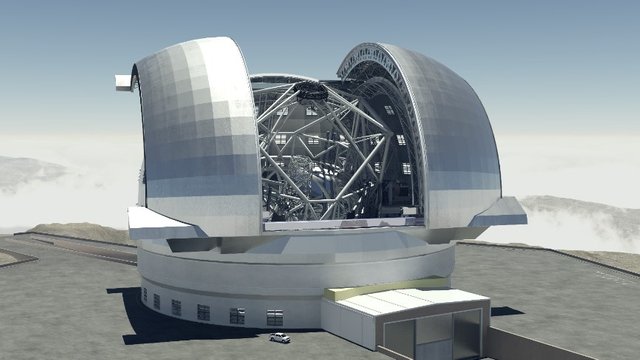Tools and the Sciences - The exploration of the Universe
As you saw in my previous article, the invention of the microscope opened the doors of a previously unknown world. The same did not happen with the world beyond Earth.
The understanding that the Earth is part of a vast universe did not require special instruments. It is known that people wondered about the twinkling lights they observed in the night sky. But the knowledge of the universe was very limited. It was not until the invention of the telescope that we really began to explore the universe. The moons of Jupiter and the rings of Saturn, for example, were not seen before the invention of the telescope.
The invention of the telescope opened the door to the incredible immensity of space and showed that our sun is a small drop in an ocean of stars. Image Pixabay.com
The telescope is an instrument used to view and amplify distant objects in space. Scientists use a variety of telescopes to study the universe: optical telescopes, radio telescopes, infrared telescopes, ultraviolet telescopes and X-ray telescopes.
Now you are going to read about the different types of telescopes and you will discover what kind of information they give us.
Optical Telescopes
The telescopes used by the first astronomers were optical telescopes. (Remember: the term optical refers to light). An optical telescope collects and focuses visible light from distant objects such as stars and galaxies. Through a series of mirrors, lenses or a combination of both, the telescope increases the image that forms the light. Optical telescopes can be refractors and reflectors.
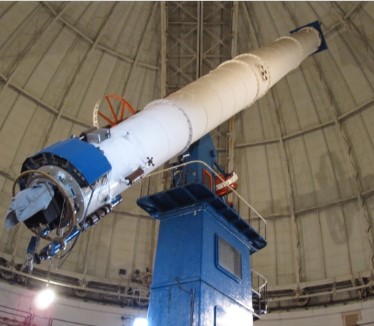
Yerkes Observatory, 40 inch refracting telescope, the world's largest. Image Source
REFRACTOR TELESCOPE In a refractor telescope a series of lenses is used to focus the light. (Remember that a microscope uses a series of lenses to magnify microscopic objects). In general, the larger the telescope's lens, the greater its ability to capture light.
The size of the telescope is determined by the diameter of its largest lens. The world's largest refracting telescope is the "40-inch" telescope at the observatory Yerkes in Wisconsin. It has the ability to capture light almost 40,000 times more than the power of the human eye!
REFLECTOR TELESCOPE In a reflector or Newtonian telescope, a series of mirrors collects and focuses light from distant objects. They use 2 mirrors, one at the end of the tube (primary mirror), which reflects the light and sends it to the secondary mirror and sends it to the eyepiece. For technical reasons, the mirrors of a reflecting telescope can be much larger than the lenses of a refracting telescope.
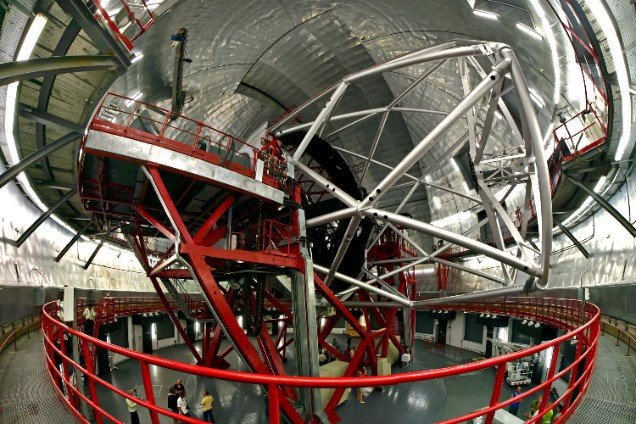
Gran Telescopio Canarias. Image Source
One of the largest reflector telescopes in the world is the Gran Telescopio Canarias at the Roque de los Muchachos Observatory, Spain. The telescope observes visible and infrared light from space with a primary mirror of 10.4 meters, segmented into 36 hexagonal glass ceramic pieces. Telescopes like this can observe objects billions of light years from Earth. It can be said that they open the door of the last end of the universe.
MULTIPLE MIRROR TELESCOPES Large reflecting telescopes are very difficult and expensive to build. Their mirrors can not have any defect. For many years, it was believed that the largest mirror that could be built was a 5-meter mirror (about 200 inches).
Telescope MMT. Image Source
To solve this problem, the Multiple Mirror Telescope was built on top of Mount Hopkins at 2,600 meters high, Arizona. That telescope had six "72-inch" mirrors. Originally it was designed in 1970, but in 1999, to increase its observation capacity, they decided to change the original system of mirrors by a simple, monolithic and light borosilicate, of 6.50 meters. Its power has increased 15 times compared to the original configuration, giving astronomers 200 times more sky in a single field.
NEW PROGRESS IN OPTICAL TELESCOPES Many types of optical telescopes are being designed and tested. It remains to be seen how many of them come to be built. In each of the models a different system is used to increase the size of the mirror.
Cerro Armazones in the Atacama Desert, Chile. Expected completion in 2022. Image Source
A new telescope in development is The Extremely Large Telescope on the Cerro Armazones, in Chile. A large-scale ground telescope with a diameter of 39 meters. I would be prepared to observe in the wavelength of the visible light, near the infrared. The telescope, in a structure of 5000 tons of weight and 80 meters high.
Radiotelescopes
When you think of the stars, you think of visible light. That's what you see when you look at the night sky. Visible light, however, is only a part of the electromagnetic spectrum. In addition to visible light, the electromagnetic spectrum includes forms of "light" that can not be detected with the naked eye. These forms of light include X-rays, ultraviolet rays, infrared rays and radio waves. Actually, many stars emit visible and invisible light. Can you see distant stars using invisible light? Yes, but not through an optical telescope.
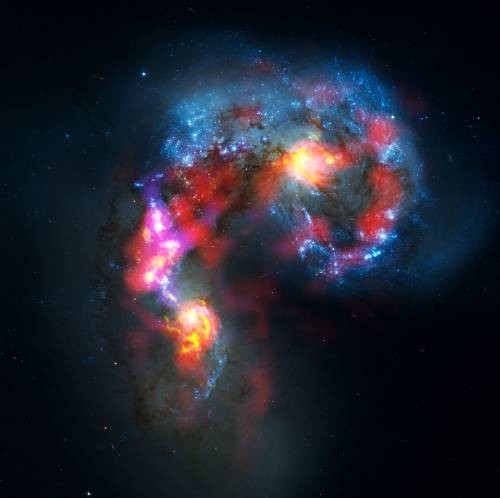
The radio telescopes have produced this image of Antena's galaxies. Image Source
The radio telescopes offered a new vision of the universe. Since many stars emit mainly radio waves (and not visible light), with the invention of the radio telescope, scientists had the opportunity to study the universe from a new perspective. It was as if a large part of the universe was hidden waiting for the discovery of the radio telescope.
An optical telescope is like a cube used to capture the light waves of space. A radio telescope is like a cube that collects radio waves from space. In most radio telescopes, a curved metal plate rises and sends the waves to an antenna. The signal that the antenna receives passes to the computers, which produce an image of the object that sends the waves. Radio telescopes generally have mobile bases to focus on anywhere in the sky. These telescopes have been able to capture radio waves of objects at a distance of 14 billion light years.
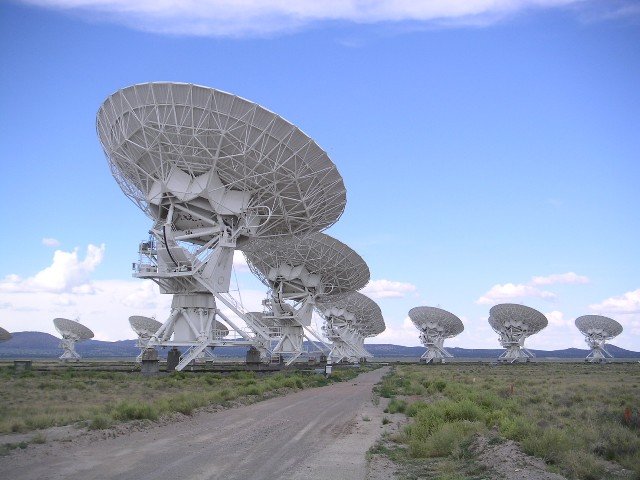
The Very Large Array in New Mexico is made up of 27 radio telescopes. Image Source
In the New Mexico desert there is a group of 27 radio telescopes known as The Great Formation or VLA that combines the power of 27 independent radio detector antennas, each of which has a disk diameter of 25 meters and a weight of 209 tons.
The antennas can be physically located in several prepared positions, which allows interferometry, acting together as a single antenna with that diameter.
Infrared and ultraviolet ray telescope
In general, stars are the only objects in space that emit visible light. But even cold, dark objects, like planets, emit infrared rays. Remember that infrared is part of the electromagnetic spectrum. Another name that is given is thermal radiation. Unfortunately, infrared rays from distant objects in space are not easily detected once they enter the Earth's atmosphere. Therefore, infrared telescopes are installed outside the atmosphere.
The ultraviolet image of the Cygnus Loop nebula captured by NASA. Image Source
In 1983 the infrared astronomical satellite (IRAS) was launched. Thanks to IRAS, the first infrared telescope in space, new and exciting information was obtained. For example, IRAS captured the heat waves of newborn stars in clouds of gas and dust at 155,000 light-years from Earth.

Estrella Vega, constellation Lira. Image Source
He also collected information that suggests that the distant star Vega is surrounded by a large cloud of matter. This cloud could be the origin of the planets. If so, IRAS has given us the first image of planets outside our solar system.
Ultraviolet light, like the infrared, is a form of invisible light in the electromagnetic spectrum. To capture ultraviolet rays, scientists have built ultraviolet ray telescopes. The ultraviolet rays of space do not easily penetrate the Earth's atmosphere. That's why ultraviolet-ray telescopes, such as infrared telescopes, are generally transported out of Earth's atmosphere.
X-ray telescopes
X-rays are another form of electromagnetic radiation emitted by stars. In fact, almost all stars emit X-rays. Of all the forms of light in the electromagnetic spectrum, X-rays are the least that cross the Earth's atmosphere. (Fortunately, because if he did, there would be no life on Earth). That's why only the X-ray telescopes can capture the X-rays of space.
In 1970, the Uhuru was launched. Uhuru gave scientists the first clear picture of X-ray sources in the sky. The Uhuru and other orbiting X-ray telescopes have provided abundant information about the life cycle of stars, particularly of very large stars when they begin to age and die.
Space telescope
The Hubble Space Telescope is a combination of several types of telescopes, each of which gives us a different picture of the universe. One of his most important discoveries was made by his ultraviolet telescope in 1991, which revealed what could be the beginning of the formation of a new solar system around a star called Beta Pictoris. "Eyes in the sky" is the nickname that scientists have given to the Hubble space telescope.
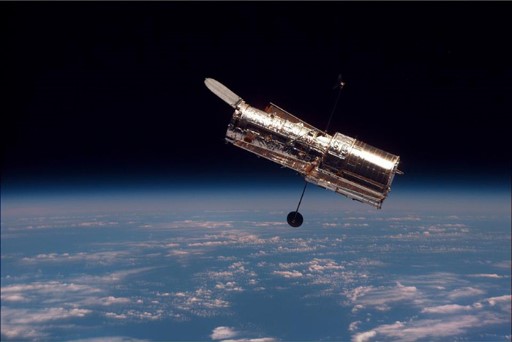
Together with the other telescopes, they promise to expand our knowledge of the universe as dramatically as van Leeuwenhoek's microscope did with the microscopic world. In a future publication, we will learn how scientists explore the planet Earth. There are still many things to learn.
Previous articles
- Tools and the Sciences - Exploring the Microscopic World
- Measurement and science - The metric system
- Discover the questions that scientists ask: Microscopic, macroscopic and global.
References website
https://es.wikipedia.org/wiki/Anexo:Mayores_telescopios_refractores_%C3%B3pticos
https://astrojem.com/instrumental/telescopiommt.html
http://www.astrocuenca.es/joomla/index.php/divulgacion/849-el-radiotelescopio
http://www.skyandtelescope.com/astronomy-equipment/types-of-telescopes/
http://www.elmundo.es/elmundo/2009/12/02/ciencia/1259769218.html
https://www.youtube.com/watch?v=mYhy7eaazIk

